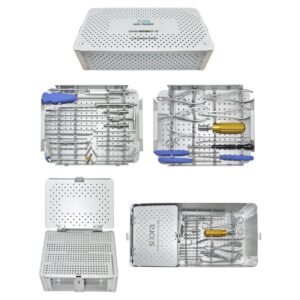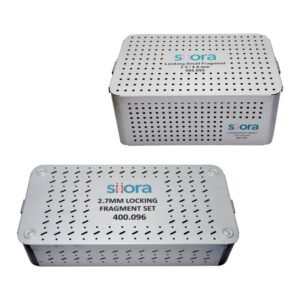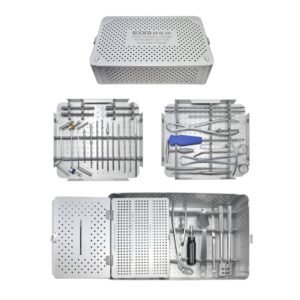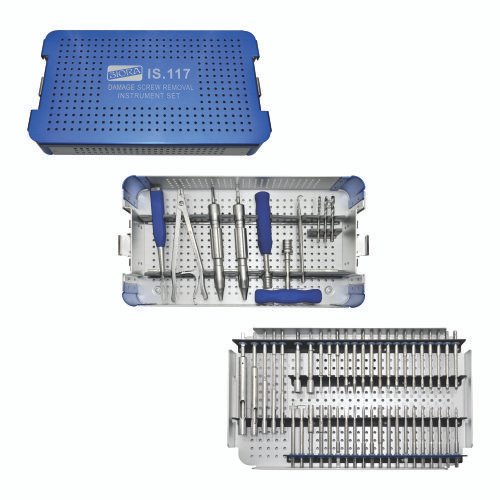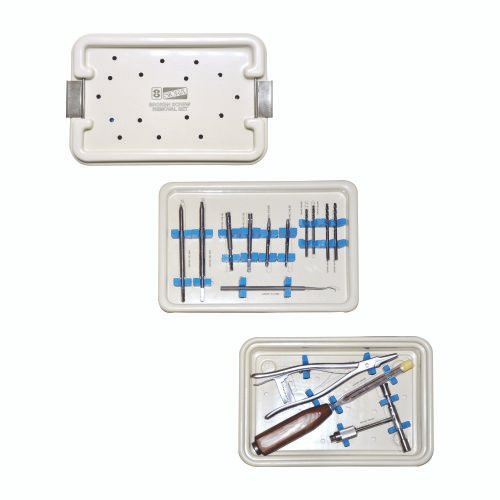Helix Locking Plate System
The Helix Locking Plate System is a cutting-edge solution designed for superior bone stabilization in orthopedic surgeries. Engineered with precision, it offers enhanced fixation, ensuring optimal alignment and stability for fractures, even in complex cases. The system incorporates advanced locking mechanisms that minimize screw backout, providing a reliable and durable construct. Made from medical-grade stainless steel and titanium, it supports faster recovery by promoting effective load distribution and bone healing. Its versatile design accommodates a wide range of anatomical variations, making it a trusted choice for surgeons. Siora’s Helix Locking Plate System delivers unmatched performance, prioritizing patient safety and surgical efficiency.
-
Small Fragment Locking Plates & Screws (55)
Small Fragment Locking Plates & Screws -
Small Fragment Locking Instrument Set (83)
Small Fragment Locking Instrument Set -
Locking Small Fragment Implant & Instrument Set (4)
Locking Small Fragment Implant & Instrument Set -
Locking Large Fragment Implant & Instrument Set (2)
Locking Large Fragment Implant & Instrument Set -
Large Fragment Locking Plates & Screws (46)
Large Fragment Locking Plates & Screws -
Large Fragment Locking Instrument Set (57)
Large Fragment Locking Instrument Set -
Damage Screw Removal Set & Instruments (55)
Damage Screw Removal Set & Instruments -
Broken Screw Removal Instrument Set (13)
Broken Screw Removal Instrument Set
What is a Locking Plate System?
A Locking Plate System is an advanced orthopedic device designed to stabilize and support fractured bones during the healing process. Unlike traditional orthopedic plates, it features locking orthopedic screws that securely anchor into the locking plate, creating a fixed-angle construct. This innovative design minimizes micro-movement, reducing the risk of implant failure and enhancing stability, especially in cases with poor bone quality, such as osteoporosis.
Locking plate systems are widely used in treating fractures in complex areas like the proximal humerus, distal radius, tibia, and femur. They are particularly beneficial in comminuted fractures, where bone fragments are highly fragmented, as they provide superior fixation and alignment. Additionally, they are instrumental in non-union or malunion cases, ensuring proper bone healing.
These systems promote faster recovery by distributing the load evenly and maintaining proper anatomical alignment. Trusted by surgeons worldwide, locking plate systems provided by Siora Surgicals enhance patient outcomes and redefine the standard of orthopedic care.
What Are the Advantages of Locking Bone Plates and Screws?
Locking bone plates and screws have improved surgical outcomes and patient care. Threaded screw holes in locking plates and threaded heads in locking screws create a perfect match to provide exceptional stability while ensuring proper bone healing. Here are the benefits of locking plate system you must know:
Enhanced Stability
Locking plates securely anchor orthopedic locking screws, reducing the risk of loosening and ensuring better stabilization for fractures, even in osteoporotic or weak bone structures.
Minimized Damage to Blood Supply
Unlike traditional plates, locking plates do not rely on compression against the bone, preserving periosteal blood flow and promoting faster healing.
Improved Load Distribution
They distribute mechanical loads evenly across the plate and orthopedic screws, reducing stress concentration and enhancing durability.
Versatility in Complex Fractures
Ideal for treating multifragmentary fractures or those in anatomically challenging locations.
Reduced Risk of Hardware Failure
The locking mechanism prevents screw backout, enhancing construct reliability and patient outcomes.
Are there any risks associated with surgery using locking surgical plates and screws?
Locking plate surgery is a widely used orthopedic procedure designed to stabilize fractures, particularly in cases of complex or osteoporotic bones. While generally safe and effective, it is not without potential risks and complications. Here are some of the potential risks that may occur with surgery involving locking bone plates and screws:
Infection
Infection is one of the primary risks, as with any surgical procedure. Proper sterilization and post-operative care are essential to minimize this risk.
Implant Failure
Another potential issue is implant failure, which can occur if the plate or screws are subjected to excessive stress or are not appropriately positioned.
Non-Union or Delayed Healing
Additionally, patients may experience delayed healing or non-union, particularly if they have underlying conditions like diabetes, poor bone quality, or if they smoke.
Irritation at the Fracture Site
Hardware irritation, where the metal plate causes discomfort or limits mobility, is another concern. In such cases, the plate may need to be removed after the bone has healed.
Nerve Damage
Nerve or blood vessel damage can occur during the surgery, although this is rare.
Reduced Range of Motion
Some patients may develop stiffness or reduced range of motion in the affected joint if rehabilitation is not followed properly.
Patients need to discuss their individual risks with their surgeon, who can provide tailored advice based on their health, age, and the specifics of their fracture. With proper care, most complications can be effectively managed or avoided.
Siora Surgicals Pvt. Ltd. is a trusted locking plate manufacturer and supplier in India with a global presence. Implants manufactured by the company are CE-certified and known to have a high success rate, even with the most complicated cases.
What is the difference between a locking plate and a non-locking plate?
Locking plates are advanced orthopedic plates that have been designed to ensure better stability. They have threaded screw holes in which the screws lock themselves with corresponding threads present on their heads. On the other hand, non-locking plates have smooth threads and their stability depends on plate and bone friction. Let us have detailed comparison:
| Feature | Locking Plate | Non-Locking Plate |
| Design | Screws lock into the plate, creating a fixed-angle construct. | Screws do not lock into the plate; rely on friction for stability. |
| Stability | Provides angular stability; less dependent on bone quality. | Stability depends on screw-plate interface and bone integrity. |
| Bone-Screw Interaction | Minimizes compression on the bone; prevents periosteal damage. | May compress bone, potentially affecting blood supply. |
| Load Sharing | Functions as a bridge; distributes load over multiple points. | Direct load transfer between plate and bone. |
| Complications | Reduced risk of screw loosening or backout. | Higher risk of screw loosening, especially in poor bone quality. |
| Cost | More expensive due to advanced design. | Less expensive and widely available. |
| Surgical Technique | Requires precise alignment to ensure proper locking. | Easier to apply but relies heavily on bone health for success. |


